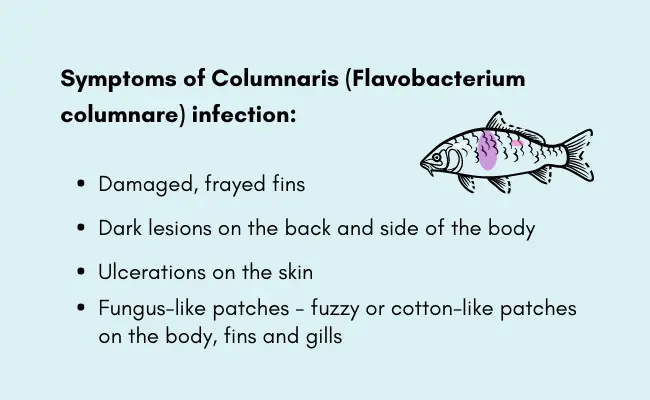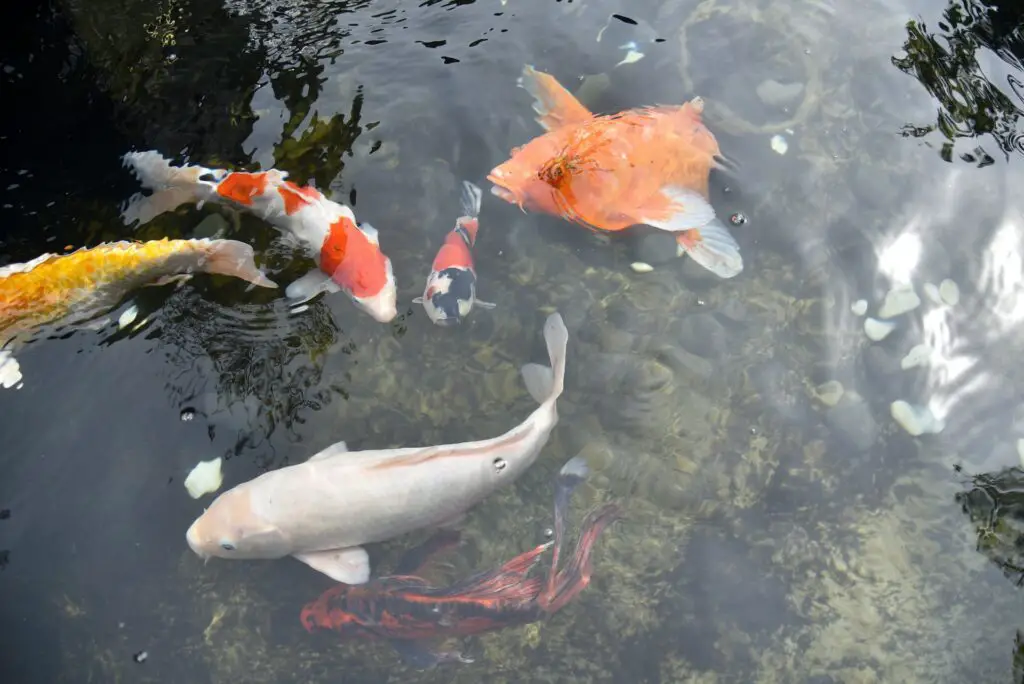It’s common symptoms include damaged fins, ulcers, and gill infections. It can eventually result in the death of the fish. Among the prevalent bacterial diseases affecting fish, Columnaris, also known as myxobacterial infection, stands out. Flavobacterium columnare is a widely spread bacterium, being able to infect many freshwater fish species. This pathogen poses a significant risk to fish populations, causing rapid infections.

What is columnaris disease?
Columnaris, caused by the Gram-negative bacterium Flavobacterium columnare, is a prevalent and significant bacterial disease that affects freshwater fish worldwide. This bacterium was previously known by different names and classifications, such as myxobacterial infection and Flexibacter columnaris. However, recent taxonomic revisions have led to its current classification as Flavobacterium columnare.
Flavobacterium columnare occurs naturally on healthy fish and aquatic ecosystems. The bacteria can persist in these reservoirs and serve as a potential source of infection.
Several factors influence the prevalence of Columnaris in fish populations. One crucial factor is temperature. Columnaris is typically more pathogenic at temperatures above 15°C (59°F). Higher water temperatures contribute to increased disease severity and mortality rates. For instance, infections can cause rapid mortality in fish within a short period, especially at higher temperatures. On the other hand, the disease is less severe at lower temperatures.
Another factor that influences the prevalence of Columnaris is the bioload or the density of fish in a given aquatic system. High fish densities can increase the risk of disease outbreaks. Stress associated with overcrowding weakens the fish’s immune system, making them more susceptible to bacterial infections, including Columnaris.
If you would like to learn about other fish diseases, have a look at this article.
Symptoms and Identification of Columnaris
One of the early signs of Columnaris infection is the fraying and ragged appearance of the fish’s fins. As the disease progresses, ulcerations develop on the skin. In some cases, fungus-like patches may also appear on the affected areas. These symptoms can be often found on the head, back (forming saddleback lesions), and fins, particularly the caudal fin.
Gill infections are less common but more severe in Columnaris. The disease starts at the tips of the gill lamellae and progressively causes necrosis, which may extend to the base of the gill arch. This strongly impacts fish’s breathing. In some cases, systemic infections may happen, leading to bacteremia and further complications.
It is sometimes difficult to differentiate Columnaris from other diseases. Similar lesions happen also in other bacterial infections. Additionally, water molds and opportunistic pathogens that can cause secondary infections in the presence of Columnaris. These secondary infections can further exacerbate the disease’s severity and complicate its management.
Causes of columnaris
Columnaris bacteria can enter fish through various routes (if not already present inside). The bacterium Flavobacterium columnare, responsible for Columnaris disease, can naturally occur on healthy fish and in aquatic ecosystems. It can be transmitted through direct contact with infected fish, contaminated water, or even on surfaces such as nets or equipment. Additionally, water molds and opportunistic pathogens can contribute to secondary infections in fish already affected by Columnaris.
Several conditions can promote the development of Columnaris infections.
- High bioloads, such as uneaten feed, create a great environment for bacteria to grow and increase the risk of infection.
- Stress caused by e.g. overcrowding, and inadequate nutrition, weaken the fish’s immune system, making them more susceptible to infections.
To that, water quality plays a significant role in the prevalence of Columnaris.
- Poor water quality, characterized by high organic pollution or elevated levels of nitrite, can create an ideal environment for bacterial growth.
- Dissolved oxygen levels are also critical, as low oxygen concentrations can stress fish and compromise their immune response, increasing their vulnerability to Columnaris infections.
- Moreover, temperature influences disease severity, with higher temperatures promoting more acute and rapid disease progression.
Minerals can impact the severity of Columnaris infections.
- The mineral content of the water, particularly hardness, affects the pathogenicity of Flavobacterium columnare. Soft water conditions are less favorable for the bacterium, potentially reducing the severity of the disease.
- Conversely, deficiencies in certain minerals can compromise fish health and make them more susceptible to infections.
- A small salt addition (max 3g per 1L, 3 ppt) can be helpful in preventing and fighting columnaris for the freshwater fish.
Diagnosis and prognosis
Beside observation of the typical symptoms of columnaris, isolation and culturing of bacteria are commonly used techniques for diagnosing Columnaris. Samples are collected from affected fish, including skin lesions or gill tissues, and cultured on specialized media.
Characteristic features of Columnaris colonies can aid in identification. Under a microscope, the bacteria appear as long, thin rods with a flexing or gliding motion. Over time, the bacteria may aggregate into masses resembling columns (this the name).
Quick and accurate diagnosis of Columnaris is crucial for determining the appropriate treatment and management strategies. If left untreated, the disease can lead to significant losses in fish populations. Therefore, it is essential to closely monitor their fish for any signs of infection and seek professional assistance for proper diagnosis and intervention.
Treatment options
When dealing with Columnaris infections in fish, quickand effective treatment is crucial to minimize the spread of the disease and improve the chances of recovery. Several treatment options are available, ranging from antiseptic baths to antibiotic therapies. However, it’s important to note that treatment effectiveness may vary depending on the stage of infection and the specific circumstances.
In the early stages of Columnaris infection, antiseptic baths can be used to control the spread of the bacteria. Potassium permanganate and copper sulfate are commonly employed as antiseptics. These baths help to disinfect the fish’s external tissues, reducing the bacterial load and preventing further progression of the infection.
Medicated fish baths are another treatment option for Columnaris. Baths with formalin or malachite green can be used. They have antimicrobial properties and can aid in reducing the bacterial load on the fish’s body surface. However, it’s important to follow the instructions carefully to avoid potential adverse effects on the fish and the aquatic environment.
Antibiotic treatments can be effective in managing Columnaris infections, particularly in more advanced cases. Antibiotics, however, should be prescribed by a vet and used as instructed to prevent resistance of flavobacterium to them!.
Temperature control is a management strategy that can complement treatment efforts. Flavobacterium columnare is known to thrive in warmer water temperatures. By lowering the water temperature within the acceptable range for the fish species, the growth and activity of the bacteria can be slowed down. This can help alleviate the severity of the infection and provide some relief to the affected fish.
Prevention and control
In this part I will make a small repetition of the causes of columnaris, but with some tips how to fix the problems.
Water quality
Clean and well-oxygenated water creates an unfavorable environment for the growth and proliferation of Flavobacterium columnare. Regular monitoring of water parameters such as pH, temperature, and dissolved oxygen levels is essential. Great and simple way to make sure our pond water is good are quick water tests like these here: pH test, oxygen test (or an oxygen meter). These links are Amazon affiliate links, meaning, if you decide to purchase something through them, I may get a small revenue from it.
Additionally, maintaining appropriate filtration systems and conducting regular water exchanges help remove organic matter and maintain optimal water quality.
Stress
Minimizing it is vital for promoting fish health and reducing the susceptibility to Columnaris. Stress weakens the immune system of fish, making them more vulnerable to infections. Providing a suitable habitat, including proper nutrition, adequate space, and appropriate water conditions, helps reduce stress levels. Avoiding overcrowding and minimizing fluctuations in temperature and water chemistry are important aspects of stress reduction.
Cleaning
Proper sanitation practices play a crucial role in eliminating potential sources of Columnaris bacteria. Thorough cleaning and disinfection of tanks, nets, equipment, and other materials used in fish husbandry help prevent the introduction and spread of the bacteria. Regular removal of uneaten feed, dead fish, and decaying organic matter from the aquatic environment also reduces the nutrient load and minimizes the growth of opportunistic pathogens.
Conclusion
In conclusion, Columnaris is a significant bacterial disease that can have a profound impact on the health of fish populations. Understanding its symptoms, causes, and risk factors is crucial for early diagnosis and effective management. Maintaining good water quality, minimizing stress factors, and implementing proper sanitation practices are vital preventive measures. Additionally, timely and appropriate treatment options, including antiseptic baths and antibiotic therapies, can help mitigate the spread of the disease. By taking proactive measures to address bacterial diseases like Columnaris, we can ensure the health of our fish.


